Cave Paintings – A Deep Dive Into Famous Prehistoric Cave Art
Despite never having contacted each other, many early cultures across the world adorned their dwellings with cave paintings and cave drawings in a very similar manner. Paleolithic cave art provides archeologists with insight into the lives, habits, diets, and rituals of prehistoric people. The oldest cave paintings typically featured basic geometric shapes and hand stencils. From the first cave paintings ever created in prehistoric cave art to the various manifestations that emerged in subsequent centuries, let’s take a look at the most interesting cave paintings.
Contents
- 1 An Exploration of Cave Art
- 2 Cave Paintings from Around the World
- 2.1 Altamira Cave, Santallina del Mar, Spain – c. 34,000 BC
- 2.2 Chauvet-Pont-d’Arc Cave, Ardèche, Southern France – c. 30,000 BC
- 2.3 Serra da Capivara, Brazil – c. 23,000 BC
- 2.4 Ubirr, Kakadu National Park, Australia – c. 18,000 BC
- 2.5 Lascaux Caves, Montignac, France – 15,500 BC
- 2.6 Tadrart Acacus, Sahara Desert, Western Libya – c. 12,000 BC
- 2.7 Magura Cave, Bulgaria – c. 8,000 BC
- 2.8 Bhimbetka Rock Shelters, Madhya Pradesh, India – c. 8,000 BC
- 2.9 Cueva de las Manos, Argentina – c. 7,000 BC
- 2.10 Laas Geel, Hargeisa, Somaliland – c. 5,000 BC
- 3 Frequently Asked Questions
An Exploration of Cave Art
Prehistoric cave artists employed a range of methods, including clay modeling, finger tracing, hand stencils, engravings, and cave paintings. Large wild creatures like horses, bison, aurochs, and deer are the most prominent topics in prehistoric cave art. The most predominant animals discovered were suited to human hunting, but they were not always the actual traditional prey discovered in related bone deposits. For instance, the artists of Lascaux left mostly the bones of reindeer, but this specific animal does not seem to appear in their cave drawings at all, whereas equines are the most prevalent.
Drawings of people were uncommon in Paleolithic cave art and were generally simplistic in comparison to the more realistic and lifelike representations of animals.
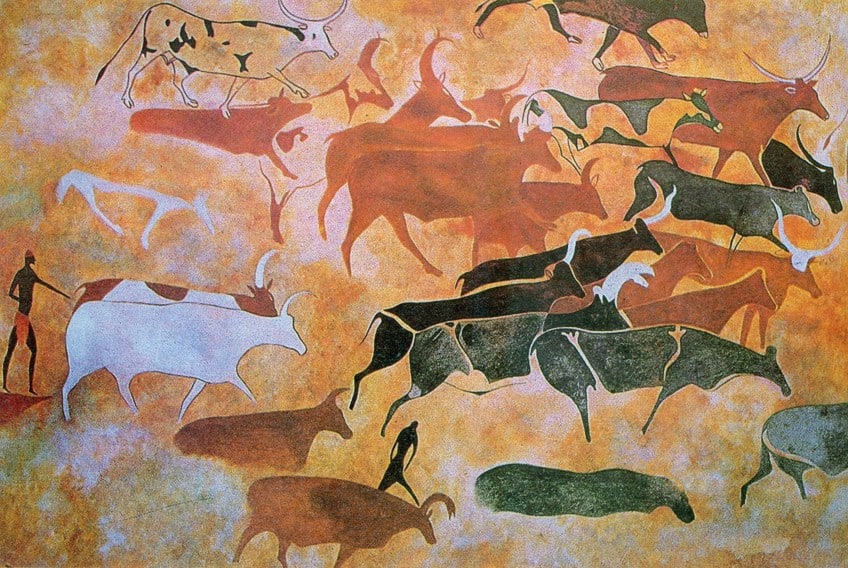
Hand stencils, created by pressing a hand against the cave wall and spraying it with pigment, produce the distinctive image of the uncolored shape of the hand in the center of the pigment, which could subsequently be adorned with dashes, dots, and various patterns. These are frequently discovered in the same cave complexes as other cave paintings, or they may be the only type of cave artwork on that specific site.
A number of hands reveal a finger that is completely or partially missing, for which a variety of reasons have been offered. Similar hand pictures may be found throughout Eastern Asia, Europe, Australia, and South America.
Cave Paintings from Around the World
Scholars regarded the paintings in the early 20th century as “utilitarian” hunting witchcraft to increase the number of animals captured during their hunts. Another explanation is that the Paleolithic cave art was created by paleolithic shamans.
The shaman would withdraw into the caverns’ darkness, achieve a trance state, and then paint representations of their visions, maybe with the intention of pulling energy from the walls of the caves directly.
Perhaps the reasons these cave drawings were created differ from region to region, or perhaps the ancient people were driven by some instinctual or primal urge to express their internal desires through their cave paintings. Let’s find out by exploring the various prehistoric cave artworks created around the globe.
Altamira Cave, Santallina del Mar, Spain – c. 34,000 BC
| Complex | Altamira Cave |
| Location | Santallina del Mar, Spain |
| Date | c. 34,000 BC |
| Subjects | Human hands, animals |
Altamira is the Spanish equivalent of Lascaux. The paintings in both caves were discovered by chance by youngsters, however, those in Altamira were discovered 60 years before those discovered in Lascaux. The first life-size replicas of the cave paintings were produced in 1964, of the stunning bison in Altamira’s cave. Altamira cave art was the first Palaeolithic cave art uncovered in Europe in contemporary times.
And it was this finding, although two decades later, that would forever alter the perception of Stone Age humans.
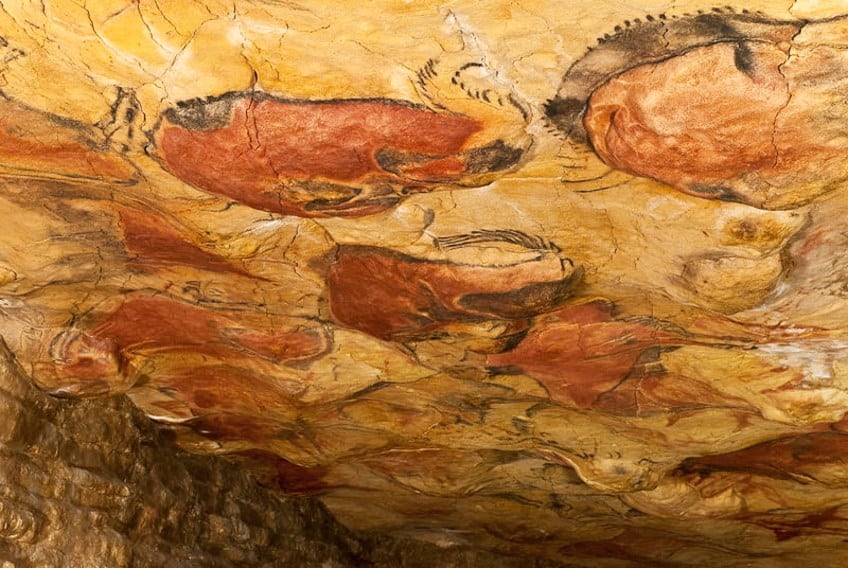
A local hunter found the cave in 1868, but it took another ten years for the real majesty of what was inside to be revealed. Don Marcelino Sanz de Sautuola, the cave’s proprietor, saw the incomprehensible black marks for the first time in 1876. He ignored them because they didn’t appear to be much and surely didn’t make sense to him. De Sautola observed engraved bone pieces while attending the Universal Exhibition in Paris in 1878. Juan Vilanova y Piera, an archaeologist, and De Sautuola started digging the layers in 1879, intrigued by the chance of discovering comparable artifacts in his cave.
Maria, De Sautuola’s eight-year-old daughter, explored the cave as her father dug the cave floor. Maria’s father was focused on the sediments he was digging, whilst Maria’s curiosity led her to look everywhere.
Maria, predictably, was the first to see the bison drawings on the cave ceiling. Maria mistook the images of the extinct bison for bulls and yelled for her father’s attention. De Sautuola wrote a fairly modest description of his efforts at Altamira the next year. He detailed the artifacts discovered during his digs in it. He immediately recognized the finely painted buffalo and matched them to bison carvings he had seen in Paris a year or two before.
Chauvet-Pont-d’Arc Cave, Ardèche, Southern France – c. 30,000 BC
| Complex | Chauvet-Pont-d’Arc Cave |
| Location | Ardèche, Southern France |
| Date | c. 30,000 BC |
| Subjects | Animals |
The Chauvet Cave complex is one of the world’s most famous ancient cave painting locations. This cave was found in 1994 by a tiny group of cavers led by Jean-Marie Chauvet in the Ardeche area of southern France, along the banks of the Ardeche river near the Pont-d’Arc. The significance of Chauvet Cave is founded on two aspects: first, the visual value of this Palaeolithic cave art, and second, its antiquity.
All of the paleolithic cave artworks have been determined to be between 30,000 and 33,000 years old.
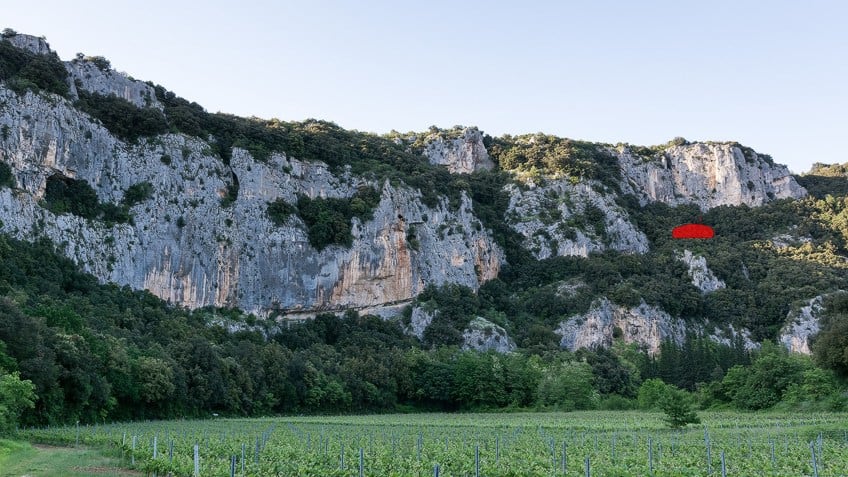
Dr. Jean Clottes, a famous French prehistorian, led the first study team inside Chauvet Cave in 1998, under strict security. The fact that these cave drawings were produced so skillfully but so far back in time has pushed us to renounce the widely held belief that “early art was unsophisticated art”. The Chauvet Cave Ice Age art is not only exceedingly ancient but also very comprehensive and diverse. Another aspect that kept prehistorians throughout the world waiting for information from the study team was that the Chauvet Cave and its Paleolithic cave artworks were almost completely preserved.
Numerous cave drawings of animals have been discovered, portraying at least 13 distinct species, some of which are seldom or never seen in other Ice Age paintings.
With a cave such as Chauvet, there’s a risk of treating it as a distinct and sanitized entity. Dr. Jean Clottes emphasizes that a painted cave, no matter how important it is, can only be comprehended in its specific site and context. It is situated in a terrain whose features affected the lifestyle and ideas of Palaeolithic people. Certainly, its art is rooted in these people’s stories and customs.
Serra da Capivara, Brazil – c. 23,000 BC
| Complex | Serra da Capivara |
| Location | Serra da Capivara, Brazil |
| Date | c. 23,000 BC |
| Subjects | Animals, humans, geometric patterns |
Before the region was designated as a National Park, access to the rock art sites was difficult and frequently dangerous. This remoteness must have increased the value of the locations, as well as those who worked on the rocks, in ancient times. These risky cave paintings were typically painted in different shades of red using ochre, which naturally spills from the nearby exposed rock outcropping; but gray and yellow paints have been employed on occasion. Each panel is often a large linear block of pictures that stretches for tens of meters.
At times, the panel spans the whole extent of a naturally occurring rock formation or overhang.
The cave art is dominated by human figures and wild animals, which are interwoven into often-complex situations including hunting, supernatural creatures, sexual activities, brawling, and dance. The creatures that frequented the area’s old brushwood forest were portrayed by the painters, including the armadillo, jaguar, tapir, lizard, and huge rhea. The most frequent of them include red deer. The animal is often just painted in outline, while other times it is completely infilled or internally ornamented with geometric patterns or rows of dots.
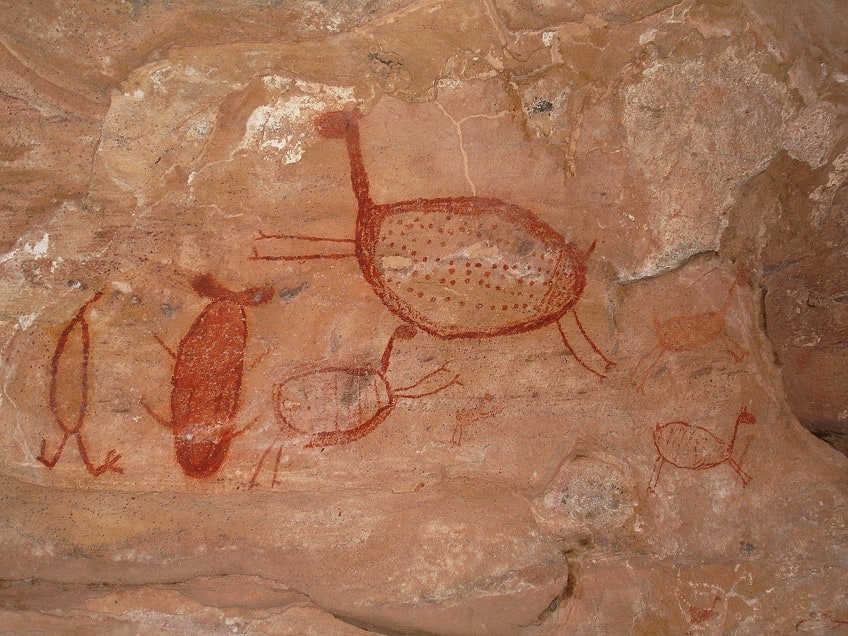
The enormous beasts are generally portrayed in groups and in a running posture, as though attempting to elude hunting groups. Lines of animal and human figures appear to be quite important to these ancient painters as well. Could those lines indicate family groups or warrior gatherings? Rows of stylized figures, some with up to 30 separate figures, were painted on a variety of panels using the inherent undulating curves of the surface layer, recalling the contours of the surrounding terrain.
In several cases, the now-extinct enormous rhea appeared in groups of three or four, implying some kind of procession.
Other intriguing, but extremely unusual, instances include images of little human figures hanging on to and leaping around a tree, maybe as part of a ritual dance – comparable to how children typically dance around a maypole. Because of the favorable environmental conditions, the picture on many panels is in amazing shape. Despite this, they have major conservation challenges that threaten their long-term survival.
Ubirr, Kakadu National Park, Australia – c. 18,000 BC
| Complex | Ubirr |
| Location | Kakadu National Park, Australia |
| Date | c. 18,000 BC |
| Subjects | Animals, humans |
Ubirr Rock, located on the border of the Nadab floodplain in the Gagudju people’s ancestral territories, is a world-renowned location of Aboriginal cave art. Although there are additional rock-face galleries in the vicinity, including those found at Nourlangie, Ubirr is the better-known site of Aboriginal ancient art in Kakadu National Park. Some of Ubirr’s Stone Age artwork is thought to extend back to the Paleolithic period, maybe as early as 30,000 BC or even before.
But, like with the Burrup Peninsula cave art, this is only a rough estimate because no artwork at Ubirr has been carbon-dated to that early a time period.
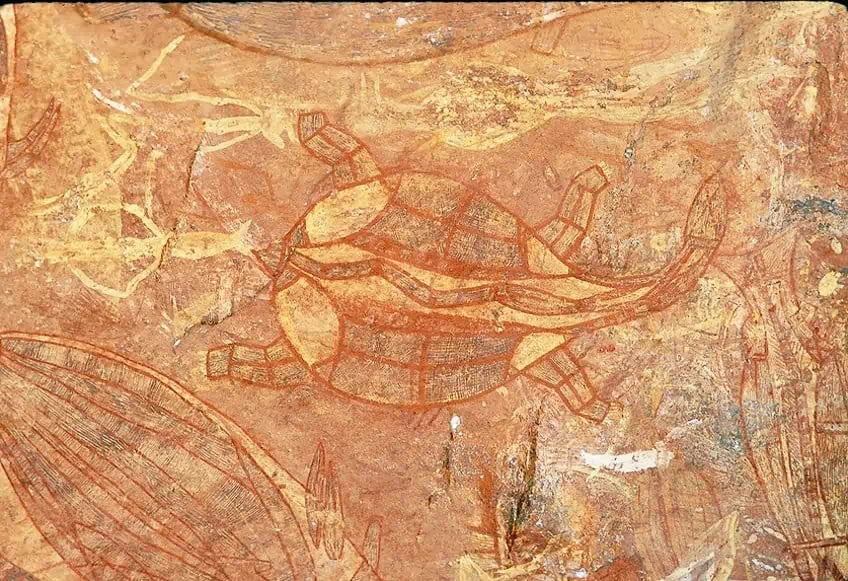
The majority of the paintings were very definitely made later in the Mesolithic and Neolithic eras, as well as into the contemporary age. As a result, the oldest art in Arnhem Land is the charcoal cave drawings by Nawarla Gabarnmang. At Ubirr, there are many accessible cave painting halls, including the Main Gallery, which is located beneath an overarching rock and features an excellent collection of Aboriginal cave paintings, and the holy Rainbow Serpent Gallery.
Aborigine painters painted a wide range of pictures, including animals, people, and scenes from the “Dreamtime”.
Ubirr’s cave paintings follow the same artistic history as all artworks in the Arnhem Land area. Due to the shifting features of the environment, artworks are divided into three major periods. These are the pre-estuarine period, the Estuarine period, and the Freshwater period, with the earliest art being of impressions of hands and other items formed between around 40,000 and 10,000 BC in the Pre-estuarine era.
Lascaux Caves, Montignac, France – 15,500 BC
| Complex | Lascaux Caves |
| Location | Montignac, France |
| Date | 15,500 BC |
| Subjects | Animals |
Four young men searching for a missing dog found the Lascaux Cave in September 1940. Only a week after seeing the caves for the first very time, historians and archeologists began working on the location to verify the figures discovered inside. The main cave is about 5 meters high and around 20 meters wide. The cave was in pristine condition when it was found; it was so completely sealed that it was unaffected by rapid temperature variations. Furthermore, it was a dry cave due to a coating of clay in the earth that made it watertight.
Paintings and carvings discovered on cave walls are referred to as “parietal art”. Painted depictions of humans are uncommon in Paleolithic cave art, and Lascaux is no different.

The majority of depictions are of animals, with some abstract symbols thrown in for good measure. The cave has only one human picture, which appears to be a bird-headed creature. The creatures pictured are representative of the flora and wildlife that people would have met during the period. Some of the feared predators featured included lions, bears, and wolves, while animals such as deer were slaughtered as part of the human diet. The strategies and instruments employed were determined by the features of the support.
For instance, in the Hall of the Bulls, the support is firm and of rough surface; in this scenario, sketching was the ideal option.
Yet, in other parts of the cave, such as the Chamber of the Felines, carving figures was viable since the limestone had already begun to dissolve due to corrosion. Another technique employed was blowing dried pigment through instruments made of hollow bones.
Tadrart Acacus, Sahara Desert, Western Libya – c. 12,000 BC
| Complex | Tadrart Acacus |
| Location | Sahara Desert, Western Libya |
| Date | c. 12,000 BC |
| Subjects | Animals, humans |
Tadrart Acacus rock-art sites are located across a large region of the desert environment surrounding the town of Ghat in south-western Libya. The Acacus mountain is included, as is the Tassili N’Ajjer world heritage site in neighboring Algeria. It is the world’s greatest rock-art location, along with the Tassili N’Ajjer, with scores of engravings and countless cave paintings.
Tadrart Acacus’ rock art dates back over 12,000 years. This magnificent open-air gallery depicts the shifting fortunes of this portion of the Sahara and the people who have lived there over the millennia.
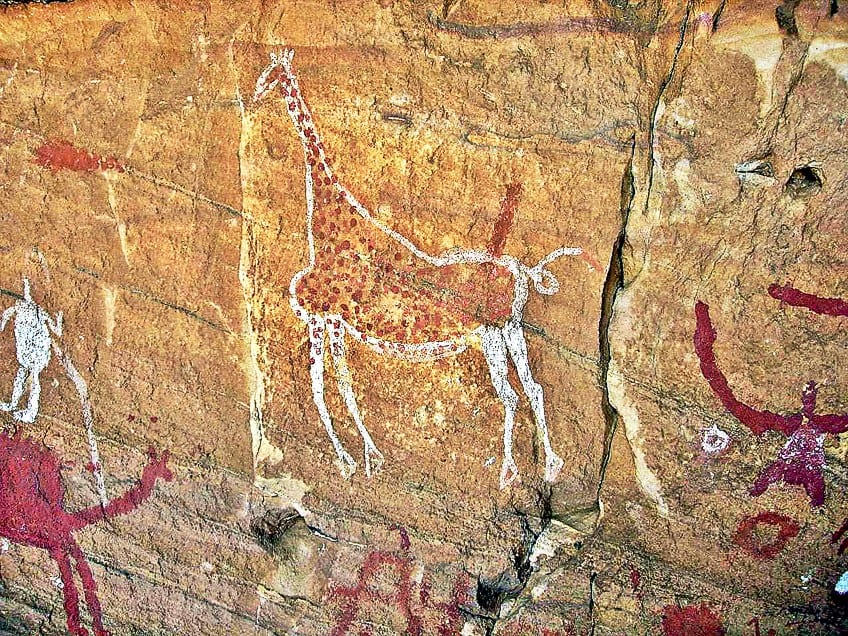
It’s a tale about the environmental repercussions of climate change, split into several periods based on the features of the rock-art heritage. The earliest art dates from the so-called Wild Fauna Period, which is distinguished by depictions of creatures including giraffes, elephants, rhinos, and hippos that lived in the region when it was considerably wetter than it is nowadays.
The Round Head Period, which overlaps with this period, shows human figures beside painted circle heads lacking details.
Humans were hunter-gatherers at the time, but this ultimately made way for the Pastoral Period, which is marked by art depicting the arrival of tamed cattle and a more established lifestyle with human figures wielding spears and conducting rites. The artwork of the Horse Period depicts the arrival of equines and horse-drawn chariots as the environment got harsher and long-distance traveling became more significant. Lastly, the Camel Phase is the most recent era of cave paintings in the Sahara, since these animals have become increasingly significant.
Magura Cave, Bulgaria – c. 8,000 BC
| Complex | Magura Caves |
| Location | Vidin Province, Bulgaria |
| Date | c. 8,000 BC |
| Subjects | Animals, humans, geometric patterns |
Some of the cave’s walls are covered in cave art dating from the Epipaleolithic to the early Bronze Age. The cave paintings are thought to have been created circa 8000 BC. The prehistoric cave art portrays significant events in the culture that inhabited the Magura Cave, including religious gatherings, hunting themes, and images of gods that are distinctive on the Balkan peninsula.
Among the most notable cave paintings are The Hunting Ceremony and The Fertility Dance. One Bronze Age cluster has been regarded as a solar calendar.
According to certain studies, Bronze Age paintings of uneven white and black squares used to tally the days in the calendar month allow us to characterize the length of time in the solar tropical year quite accurately. The cave paintings enabled the storage of knowledge regarding traditions, the regional solar calendar, societal rites, and religious festivals. The medium for the cave artwork was bat guano. Zoomorphic, anthropomorphic, geometric, and symbolic figures are the four theme groupings of painted images.

There are ithyphallic figures, archers, humanoid figures with arms raised, and “fungi forms” in the first group. There are bovids, caprids, dogs, big birds, and linear quadrupeds among the zoomorphic objects. T-shaped figures, vertical parallel lines, vertical parallel zigzags, horizontal zigzags, branch-like figures, rhombi, checkerboard patterns, crossed circles, and honeycomb patterns are examples of geometric symbols. A few rayed circular figures, most likely the two unica of the so-called calendar image, portray a sun.
It is possible to identify dancers, hunters, and mating themes by counting several connected figures.
A massive horizontal dancing and hunting scene is shown in the so-called Cult Hall, grouped in two major rows: these are the most recognized and most replicated Magura Cave artworks. Access to the cave artworks is limited to protect them. Before 1993, the cave was not protected and was open to the public. As a result, some of the cave artwork have been vandalized, and the walls have been scraped. The cave is currently open all year, although the cave drawings may only be seen with the supervision of a guide.
Bhimbetka Rock Shelters, Madhya Pradesh, India – c. 8,000 BC
| Complex | Bhimbetka Rock Shelters |
| Location | Madhya Pradesh, India |
| Date | c. 8,000 BC |
| Subjects | Animals, humans, linear forms |
There are several murals at Bhimbetka’s caves and rock shelters. The first cave paintings in this region have been discovered to be 10,000 years old, yet some of the geometrical shapes date back to the medieval period. Because the designs were often produced deep inside a crevice or on interior walls, the colors employed have withstood the test of time. The cave drawings and paintings are divided into seven distinct eras. Human hunting and dance were shown in green linear representations in Upper Paleolithic artworks.
The stylized figures of this group, which were comparably smaller in size during the Mesolithic period, feature linear embellishments on the body.
Aside from animals, there are also human figures and hunting scenes, which show the weaponry they utilized: barbed spears, sharp rods, arrows, and bows. Some images are understood as showing tribal warfare between different tribes, each represented by a unique animal totem. Rhythmic movement depicts collective dances, fowl, musical instruments, children and mothers, men carrying prey, drinking, and burials.
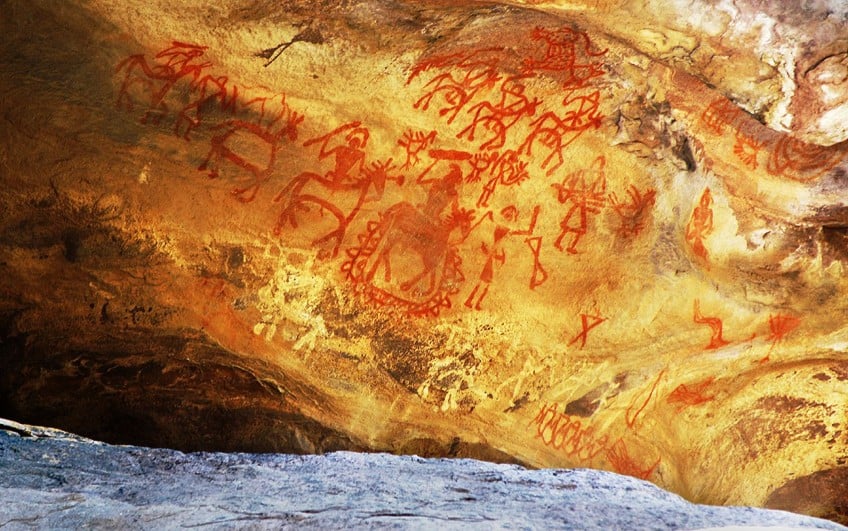
The Chalcolithic cave paintings were comparable to Mesolithic paintings in that they demonstrate that during this era, the cavemen of this area were in touch with the agricultural populations of the Malwa plains, exchanging commodities with them. Characters in this group have a geometrical and ornamental style and are colored mostly in white, red, and yellow in the Early Historic era.
The subjects were horsemen, religious symbols, tunic-like garments, and the survival of texts from various times. Religious symbols include yakshas, tree deities, and supernatural sky chariots.
Medieval cave paintings are more linear and more schematic, yet their artistic style shows degradation and crudeness. The cave inhabitants’ hues were created by blending red hematite, black manganese oxides, and charcoal. One boulder, known as “Zoo Rock,” portrays swamp deer, elephants, and bison.
Another rock has depictions of a snake, a peacock, a deer, and the sun. Hunting scenes with hunters wielding arrows, bows, spears, and shields are also shown in this group of pre-historic paintings. In one of the tunnels, a bison pursues a hunter as his two colleagues wait hopelessly nearby; inside another, horsemen and archers are depicted. A big wild bovine may be seen in one of the paintings.
Cueva de las Manos, Argentina – c. 7,000 BC
| Complex | Cueva de las Manos |
| Location | Santa Cruz Province, Argentina |
| Date | c. 7,000 BC |
| Subjects | Animals, people, hands |
Cueva de las Manos is characterized by the multitudes of hand cave paintings sprayed onto the rock walls in numerous collages. These cave artworks are among the most significant in the New World, and it is by far the most well-known cave art in the Patagonian region. The artwork was created during the Archaic period, from 7,300 BC to 700 AD. According to some historians, the cave paintings in Cueva de las Manos have the oldest cave paintings in all of South America. The artwork adorns the cave’s inside as well as the surrounding cliff sides.
It is organized into three primary divisions based on these subjects: humans, the animals they consumed, and human hands.
Over time, the cave was occupied by several generations of humans. The age of the works of art can be determined using the remnants of bone pipes used for splattering paint on the cave walls to produce the hand collages, as well as the radiocarbon dating of the works of art directly. A chemical study of the pigments used to produce the artwork, as well as stylistic features and superimposition overlap of the various portions of the picture, have confirmed its authenticity.
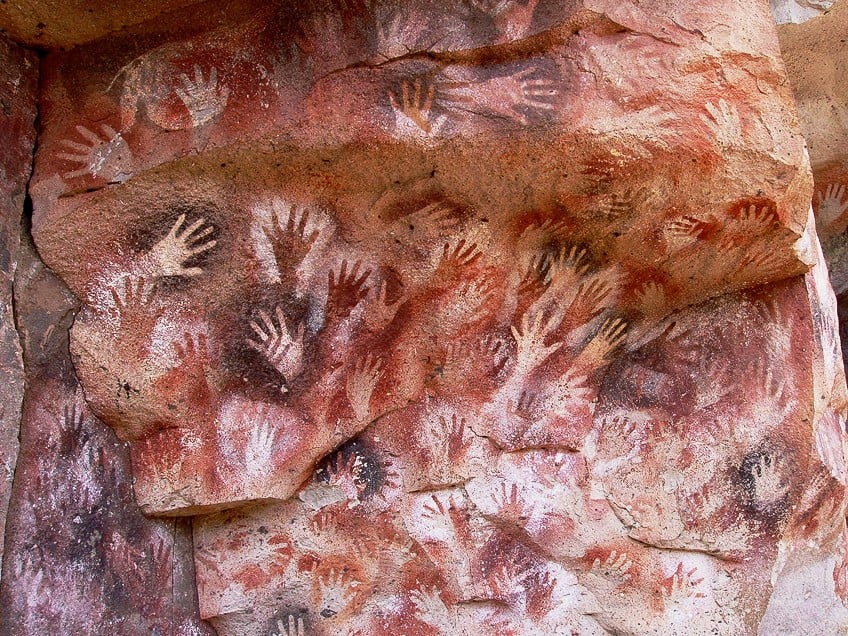
Scholars believe it is the greatest tangible evidence of early South American hunter-gatherer societies. Apart from the implements they utilized and the animals they killed, nothing is known about the civilization of the individuals who created these artworks. It is left to contemporary academic studies to hypothesize about their civilization and what existence was like in the cultures that made it. However, the fact that so many individuals contributed to these cave artworks over centuries implies that the cave was important to the individuals who drew on its walls.
The art demonstrates that the inhabitants of this region had a symbolic aspect of their culture.
Irrespective of its intention, the cave artwork had an important role in the shared social memory of the people who lived in the area, with older groups affecting later ones through a millennium-long story. The motifs in the cave art depict important features of a hunter-gatherer society, such as group hunting. The place also held a profound social and personal link for the creators, since the same groups came to the area yearly and made art at the cave, which served as a type of ritual.
Laas Geel, Hargeisa, Somaliland – c. 5,000 BC
| Complex | Laas Geel |
| Location | Hargeisa, Somaliland |
| Date | c. 5,000 BC |
| Subjects | Animals, humans |
Laas Geel, one of the most prominent cave painting locations in the region, is located in Somaliland, on the route between Berbera and Hargeisa. The location is on a granite overhang that arises from a plateau at an elevation of 950 meters above sea level, near the intersection of two intermittent rivers, which helps to explain the presence of cave paintings in the outcrop. Even now, the name of the place alludes to the presence of water near the wadi’s surface.
The panels are arranged in three levels and are predominantly located on the outcrop’s eastern edge, however scattered portrayals can be found on other slopes.
A French team studying the beginnings of pastoralism in the Horn of Africa identified the site in 2002. Along with the murals, lithic artifacts were discovered dispersed across the site, as well as burials marked with stelae and mounds. The paintings are spread across 20 rock shelters, the largest of which is approximately 10 meters in length. The majority of them are cows with curving white horns and distinctive udders. Cave paintings are extremely colorful, with white, red, black, brown, violet, and yellow used both alone and in combination.

The most distinguishing aspect of these cows is their necks, which are shown as rectangular, unnaturally broad, and either empty or filled with wavy or straight white and red stripes. Cows occur alone or in clusters of up to 15, though no distinct depiction of herds can be seen.
They are frequently paired with human figures that have a relatively uniform shape: frontally shown with arms spread to the side and donning a type of shirt, generally white.
Heads are tiny and occasionally crowned with a corona of radial stripes. These figures are always associated with cows, appearing between their legs, underneath the neck, or behind the hindquarters. In certain circumstances, they are armed with a bow, a staff, or a shield. Dogs, like people and cows, are well-portrayed and are frequently placed alongside human figures.
Prehistoric cave art allows us to observe the fact that art has been around just as long as humans have – in fact, possibly even longer, since there are cave drawings that we made by a species that was not yet even human. Thanks to the oldest cave paintings yet found, we can peek into the past and observe the way in which our ancient ancestors lived. From the first cave paintings ever produced, to the modern digital realm – we have certainly come a long way.
Take a look at our cave art webstory here!
Frequently Asked Questions
Why Did Early Humans Produce Cave Drawings?
Nowadays, we perceive art as a leisurely pursuit. For people of the ancient past, it was a means of communication and documentation. They could record what kind of animals they hunted and ate, as well as ceremonial practices. From these cave paintings, we are able to learn much about a culture that had no written language.
What Did Humans Portray in Their Cave Paintings?
Animals were the most dominant subject matter in prehistoric cave art. This makes sense as that is what kept them alive, and they believed that by drawing out their upcoming hunts, they would be sure of a better catch. Other popular themes were human figures and geometric patterns.
Jordan Anthony is a Cape Town-based film photographer, curator, and arts writer. She holds a Bachelor of Art in Fine Arts from the University of the Witwatersrand, Johannesburg, where she explored themes like healing, identity, dreams, and intuitive creation in her Contemporary art practice. Jordan has collaborated with various local art institutions, including the KZNSA Gallery in Durban, the Turbine Art Fair, and the Wits Art Museum. Her photography focuses on abstract color manipulations, portraiture, candid shots, and urban landscapes. She’s intrigued by philosophy, memory, and esotericism, drawing inspiration from Surrealism, Fluxus, and ancient civilizations, as well as childhood influences and found objects. Jordan is working for artfilemagazine since 2022 and writes blog posts about art history and photography.
Learn more about Jordan Anthony and about us.
Cite this Article
Jordan, Anthony, “Cave Paintings – A Deep Dive Into Famous Prehistoric Cave Art.” artfilemagazine – Your Online Art Source. November 18, 2022. URL: https://artfilemagazine.com/cave-paintings/
Anthony, J. (2022, 18 November). Cave Paintings – A Deep Dive Into Famous Prehistoric Cave Art. artfilemagazine – Your Online Art Source. https://artfilemagazine.com/cave-paintings/
Anthony, Jordan. “Cave Paintings – A Deep Dive Into Famous Prehistoric Cave Art.” artfilemagazine – Your Online Art Source, November 18, 2022. https://artfilemagazine.com/cave-paintings/.



